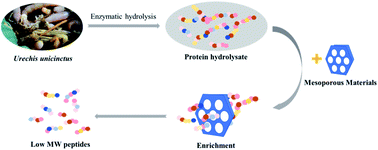The efficient enrichment of marine peptides from the protein hydrolysate of the marine worm Urechis unicinctus by using mesoporous materials MCM-41, SBA-15 and CMK-3†
Abstract
Peptides found in marine life have various specific activities due to their special growth environment, and there is increasing interest in the isolation and concentration of these biofunctional compounds. In this study, the protein hydrolysate of the marine worm Urechis unicinctus was prepared by enzymolysis and enriched by using mesoporous materials of silica MCM-41 and SBA-15 and carbon CMK-3. The differences in pore structures and elemental composition of these materials lead to differences in surface area and hydrophobicity. The adsorption capacities of peptides were 459.5 mg g−1, 431.3 mg g−1, and 626.3 mg g−1 for MCM-41, SBA-15 and CMK-3, respectively. Adsorption kinetics studies showed that the pseudo-second-order model fit the adsorption process better, where both external mass transfer and intraparticle diffusion affected the adsorption, while the Langmuir model better fit the adsorption of peptides on MCM-41 and SBA-15 and the Freundlich model was more suitable for CMK-3. Aqueous acetonitrile (ACN, 50/50, v/v) yielded the most extracted peptides. MALDI-TOF mass spectrometry of the extracted peptides showed that the three mesoporous materials, especially the CMK-3, gave good enrichment results. This study demonstrates the great potential of mesoporous materials in the enrichment of marine biofunctional peptides.



 Please wait while we load your content...
Please wait while we load your content...